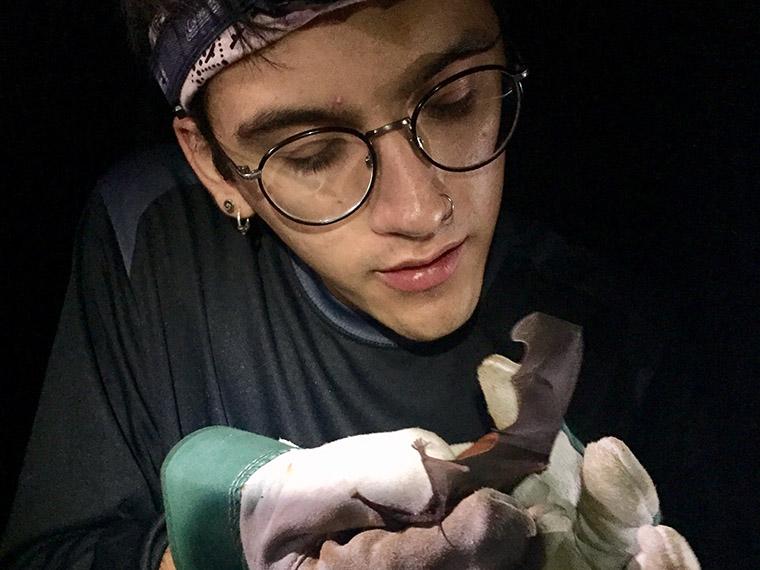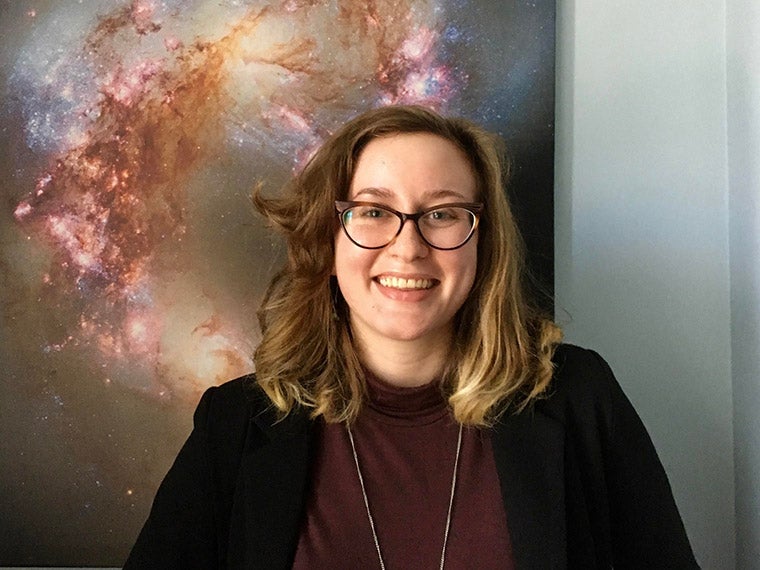From Catching Bats to Fighting Cancer: How Three Science Students Spent Summer Break
August 3, 2017
Hillary Hempstead

Biology and environmental studies major Juan Contreras spent the summer studying bats in Puerto Rico's El Yunque National Forest.
Photo credit: Courtesy of Juan Contreras
Some might think of bats as disease-ridden, aggressive, and downright unappealing. But third-year Juan Contreras says, “They’re some of the cutest animals I have ever seen!”
The biology and environmental studies major views these creatures differently because, as part of a National Science Foundation-Research Experience for Undergraduates (NSF-REU) program, he spent the summer studying them.
In Puerto Rico’s El Yunque National Forest, Contreras explored the host-specificity of parasites on bats—specifically, whether particular parasites only attach themselves to certain species of bats. To do this, Contreras, with a group of student researchers, spent weeks collecting samples from the 13 species of neotropical bats who live in a large network of caves.
“When we go sampling for bats, we typically have two people stationed at the cave entrance with the trap and someone else who runs the bats from the cave to our sampling area,” says Contreras.
The students wear personal protective equipment to collect the bats’ sex, species, reproductive status, forearm length, weight, ectoparasite load, ectoparasite samples, and fecal samples. The data that Contreras and the other student researchers collected will be used in a University of Connecticut PhD student’s thesis on bat viruses.
“We take the ectoparasites off with soft tweezers that won't crush the parasites body,” Contreras says. “Most of the time, the ectoparasites are fairly easy to take off of a bat’s body. Because bats typically have many ectoparasites, we try to take at least one of each observable species, and then record a general estimate of quantity in our field notebooks.”
For Contreras, the summer experience expanded his view of who a scientist can be. “Growing up in the south side of Chicago and coming from an immigrant family, a master’s degree or PhD has always seem like a farfetched idea. But working among scientists that often only speak Spanish, with scientists who look like me and come from humble beginnings, has validated my identity as a scientist and has pushed me to continue to achieve my goals.”
Astrophysics Research in Montreal
This summer, fourth-year physics major Stella Ocker found herself part of a tightly knit group of astrophysics professors, postdocs, grad students, and undergrads at Montreal’s McGill University. There, she worked as a research assistant with Victoria Kaspi at the McGill Space Institute.

The subject of her research was the repeating fast radio burst, a “mysterious source located in a dwarf galaxy” that has been producing frequent radio bursts (FRB) of unknown cause. “The bursts don't have a known periodicity, which means we can't predict when the next burst will arrive,” says Ocker.
“The goal of my project is to determine whether or not the bursts' arrival times can be modeled by some kind of Poissonian distribution, which is a statistical distribution used to model independent, random events.” Ocker and Kaspi have also been exploring whether there is another way to analyze the collected data.
“We’re hoping by the end of the summer we will have a definitive answer as to whether the repeating FRB can be described by a Poissonian distribution or not. And if not, we’ll have some rough idea of alternative statistical distributions that could describe it,” says Ocker.
Research with a Giant Telescope in China
Highly magnetized neutron stars, known as pulsars, are the remnants of large main-sequence stars after they exhaust their fuel and explode in supernovae. Their cores collapse and they rotate, generating a strong magnetic field and emitting electromagnetic waves. Scientists detect these pulsars by using radio telescopes.
This summer, second-year physics major Shana Li gained experience with the world’s largest single-dish radio telescope, the 500-meter Aperture Spherical Telescope, or “FAST” for short, located in China’s Guizhou province.

Li, along with a student from the University of Wisconsin-Milwaukee, worked under Professor Di Li of the National Astronomical Observatory of China on pulsar data analysis by writing code to run data through FAST's data processing pipeline to find pulsar candidates.
“The goal of my project in China was mainly to gain some research experience working with the professors and postdocs and to refine some of the skills—computing, data understanding, analysis—that I can use in future research back in Oberlin and in other places,”says Li.
However, her personal goal was more simple. “[I want] to just learn as much as possible while I'm surrounded by so many professionals. I hope to hone my research skills and be more confident in an intensive research environment. Of course, it would be super cool to find a new pulsar!”
You may also like…
Josh Nolan Named Vice President, General Counsel, and Secretary at Oberlin
Distinguished attorney brings extensive experience in higher education law.
Learning by Teaching: Oberlin Students Share Global Music with Young Learners
College and Conservatory students in PACE 103 prepare local children for an immersive community concert at Oberlin.
Nuiko Wadden ’02 Joins Oberlin Conservatory Faculty as Assistant Professor of Harp
The versatile musician brings extensive opera, orchestral, and contemporary music experience to her role


